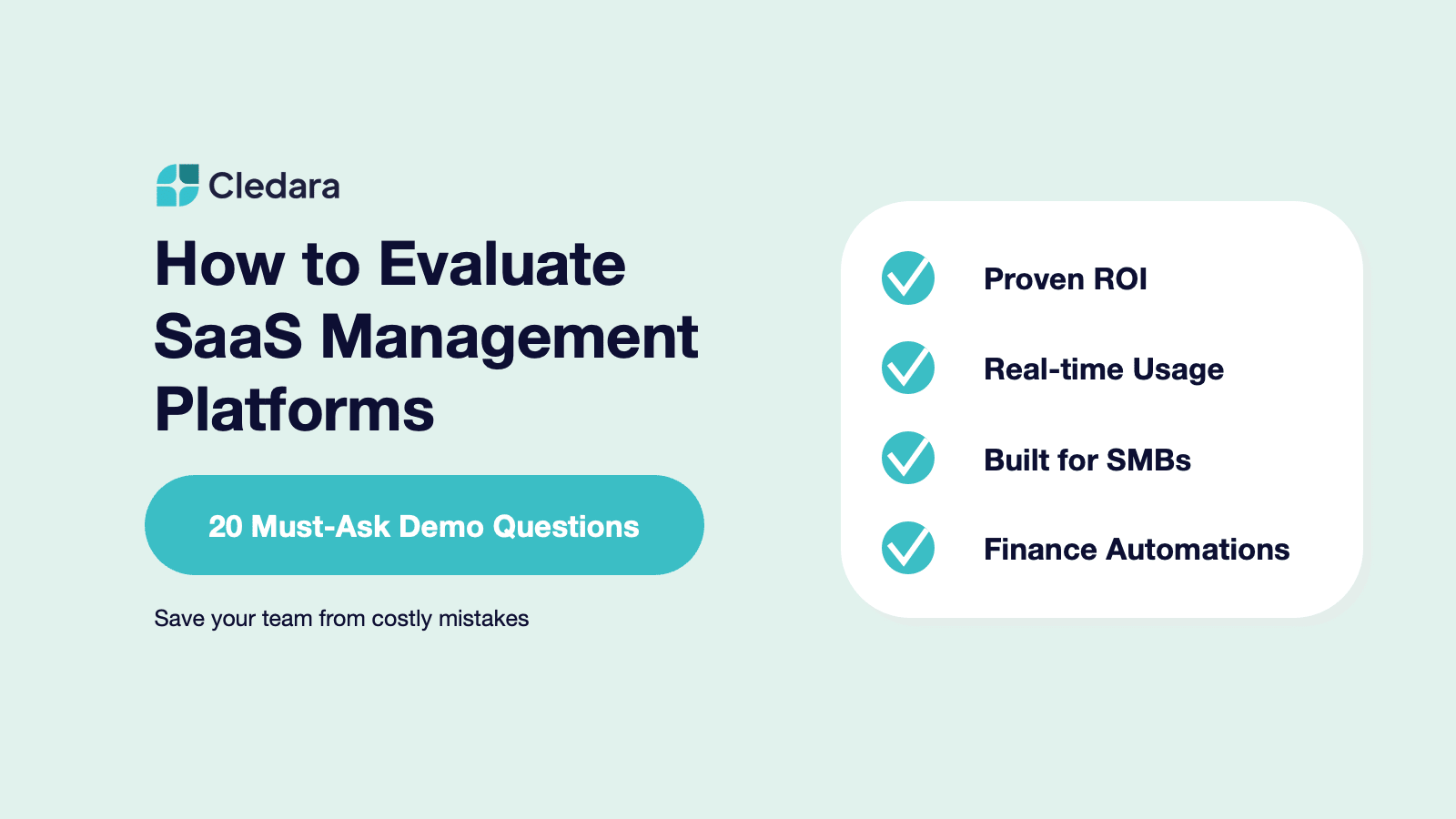Tail expenses are quite common in growing businesses. But while your Procurement team is probably aware of them, most of the time, not much is done to track and control them.
During times of crisis or instability, Finance tends to prioritize cutting major expenses. However, they often overlook tail spends. According to the experts, the potential annual savings derived from managing tail spend can be up to 10%. And as you may know, companies' second largest asset is software.
In this post, we’ll share how to manage tail spend in software.
What Is Tail Spend?**
There is no standard definition for tail expenses. Each company establishes its own based on its size, needs, and expenditure patterns.
However, in broad terms, tail expenses refer to small expenditures that might seem insignificant when made individually but can accumulate over time and impact your overall budget.
Typically, tail spend is defined using the Pareto rule. It suggests that tail spend accounts for 20% of your expenses made to 80% of your suppliers. Meanwhile, strategic spending represents 80% of your expenditures with 20% of your suppliers.
.webp)
There are different kinds of tail spend, including:
- Maverick expenses
- Tactical expenses
- One-time expenses
Let’s take a closer look.
Maverick Expenses
Maverick expenses, also known as rebel spending, are unauthorized purchases made outside of the company's established procurement process. It usually implies bypassing agreed contracts with preferred suppliers.
Maverick's expenses can arise when employees are either unaware of the procurement protocols or simply choose to ignore them.
Tactical Expenses
Tactical expenses happen outside the authorized channels but for good reasons. Sometimes there are specific circumstances in business that require a fast response. For example, let’s say that your team needs certain software for a presentation in a couple of hours. Typically, getting this purchase approved through the authorized channels would take much longer and delay your team. All in all, these purchases are considered tactical because their main purpose is to keep operations running smoothly.
One-time Expenses
These are one-time or very infrequent expenses. In this case, employees are aware of the procurement protocol but believe it’s not worth the effort for a one-time or low-cost purchase. For example, buying food for an employee's farewell party.
What is Software Tail Spend?**
Software tail spend is when either maverick, tactical, or one-time expenses apply to software purchases. In such cases, the purchases are made without a strategic approach, involving multiple suppliers, and outside of the authorized channels.
Shadow IT is a clear example of software tail spending. It occurs when team members subscribe to SaaS tools without the IT or Procurement team's approval. As a result, it’s difficult to keep track of these costs and control how these applications are used.
Why Does a Tail Spend Occur?**
Typically, tail expenses result from the lack of:
- Clearly defined policies
- Visibility
- Streamlined process
Lack of Clear Policies
When it comes to major purchases, businesses typically have well-defined policies and procedures in place. However, infrequent and inexpensive purchases are often overlooked.
Sometimes, companies don’t set processes for these purchases. Other times, there are processes in place, but they’re simply not well communicated across the company. Therefore, a lot of tail spending happens because employees don't even know there’s a process for purchasing a certain asset.
On the other hand, tail spending often happens because team members simply disregard such policies as well. In this scenario, this is a symptom of mismanagement at a broader level.
Lack of Visibility
As already mentioned, these expenses are often minor and occur outside of traditional purchasing channels. Consequently, companies don’t tend to keep detailed records of them. Without full visibility, tracking, analyzing, and controlling these expenses becomes more challenging.
Lack of Streamlined Processes
Just because you set policies and processes, that doesn’t mean that everyone will follow them. Employees may avoid procurement processes if they find them unclear, time-consuming, bureaucratic, or if they hardly ever get a purchase approved. In other words, poorly designed procurement processes often contribute to tail spend.
The Risks of Software Tail Spend**
Tail spending is not necessarily bad. They happen all the time, and companies know it. However, software purchases aren’t the same as buying food for a farewell party.
Software tail spends imply purchases and subscriptions that don’t have the support or management of IT or other relevant stakeholders.
Therefore, it conveys some challenges, including:
- Security risks
- Uncontrolled spending & neglecting negotiation opportunities
- Work silos
Security Risks
Unauthorized software can expose your company to multiple risks, including:
- Data breaches
- Compliance issues
- Introduction of malicious code
IT experts must thoroughly evaluate software to guarantee its reliability.
Uncontrolled Spending & Neglecting Negotiation Opportunities
Tail spending on software involves small purchases such as:
- Plug-ins and add-ons
- Software upgrades
- Subscribing to inexpensive cloud services (e.g. project management tools, internal communication tools, etc.)
While each individual expense might seem minor, they can add up to be a significant expense when combined. Plus, these unrevised purchases bypass the opportunity to choose vendors based on negotiating terms. In other words, organizations miss out on securing better pricing, favorable payment schedules, volume discounts, or additional benefits.
Work Silos
Tail spending on software can end up in the following work silos:
- Redundant Purchases - when different departments make software purchases independently, they often make decisions based on their specific needs without considering the overall business objectives. This can result in different teams using different software for similar tasks.
- Compatibility Issues - the unauthorized tools may not integrate well with each other, hindering cross-departmental collaboration and data sharing.
- Training and Support - Providing effective training and support to all employees becomes challenging when there are numerous diverse software tools in use, especially if these tools are not widely adopted across the organization.
The Benefits of Tail Spend Management**
Experts agree that managing tail spend can result in annual savings of between 5% and 10%. But there are many other advantages too, including:
- Reduced budget variance and accurate forecasts - Now that fewer expenses are slipping through, you can allocate resources more effectively, and your forecasts are more reliable.
- Improved compliance - By working exclusively with authorized suppliers, you can ensure that you are in compliance with industry regulations.
- Increased employee productivity - People become more productive when they have easy access to the tools and resources they need.
- New saving opportunities - Once you learn what you’re actually spending on, you can identify repeated or unnecessary expenses. Plus, you may even find savings opportunities to negotiate with your vendor.
Managing Tail Spend on Software: Where Should You Start?**
Now that you know the impact of software tail spend, let’s see how to implement a management program. The specifics may vary depending on your organization's unique needs and scale. Yet, here are some key steps that you should consider:
- Define the scope
- Set a supplier database
- Implement training
- Get full visibility
- Adopt Automation
1. Define the Scope
As previously mentioned, tail spend doesn’t have a universal definition and varies from company to company. Therefore, you should start by precisely defining what tail spend means within your specific organization.
You can define tail spending by:
- Setting a spending cap - For instance, considering purchases under $150 as tail spend.
- Considering the size of your supplier - small vendors may be a good candidate for tail spending.
- Taking into account the purchase frequency - For example, yearly purchases.
- Other criteria - according to your company's needs and nature.
After all, if you want to measure and bring clarity to tail spend, you need to have a precise understanding of what it means for you.
2. Set up a Supplier Database
Establishing a database of authorized suppliers can significantly help prevent obscured tail spend. By maintaining a comprehensive database, teams can easily search for the required software from vendors who have already been approved.
3. Implement Training
It serves no purpose to have a well-defined understanding of tail spending or a detailed database if your team members aren’t aware of them. Ensure that you train your staff on avoiding tail spend, its risks, and the importance of following the right procedures.
4. Get Full Visibility
While it may be challenging to control every expense, it is crucial to make an effort to track as many of them as possible. By gaining comprehensive visibility into your software stack, you can enhance control over your tail spend and work towards optimizing it.
5. Adopt Automation
You can improve your expense monitoring by automating most of your operations, including software tracking and software procurement. Automating processes not only prevents human errors, but also makes them traceable and controllable. SaaS management tools can be your greatest ally here.
Say Goodbye to Software Tail Spend With Cledara**
Managing tail spend is often overlooked when adjusting budget variance. However, it can make a significant difference, especially in fast-growing companies where processes and expenses are always changing and can easily spiral out of control.
Managing your software tail spend requires full visibility over all your software expenses and streamlined approval processes. Luckily, a good SaaS management platform can automate all of this. Here’s where Cledara steps in.
Cledara is the only SaaS management platform that allows you to:
- Get a centralized view of your entire software stack
- Streamline key steps of the procurement process, from request to purchase
- Identify redundant tools and unsubscribe with one click
- Have individual virtual cards for every SaaS subscription and set budget limits
- Ensure compliance with procurement policies
- Have a single place to manage vendor contracts, payments, and software subscriptions
- Get valuable insights and reports over software usage across the company
- Collaborate effectively with Procurement, IT and Finance teams
- and more
Take control of your SaaS stack. Book a demo today.


















.webp)
.webp)
%2520(1).webp)